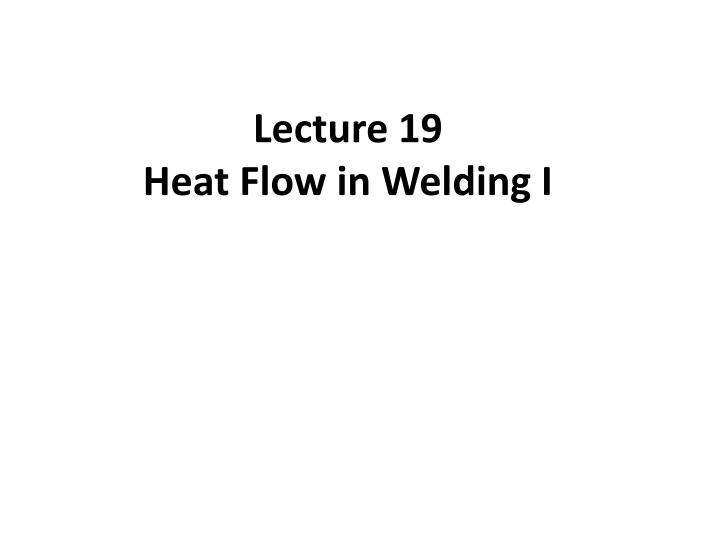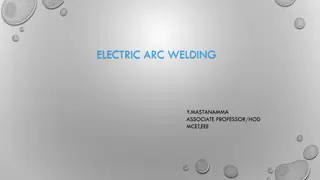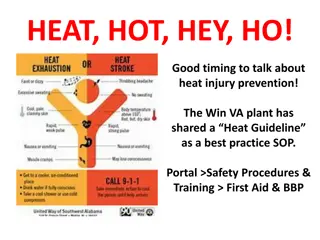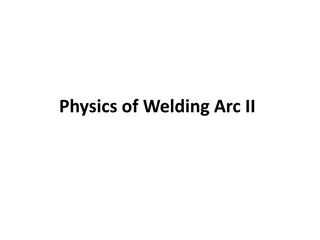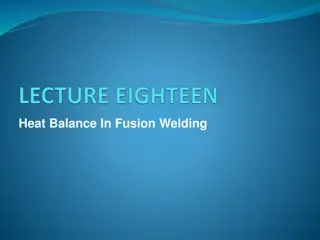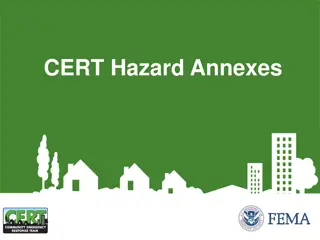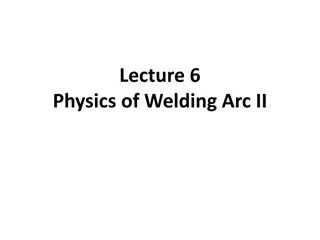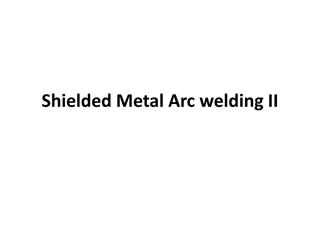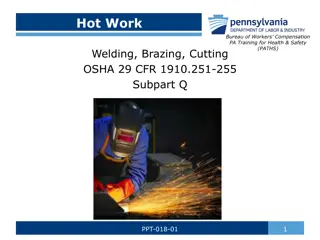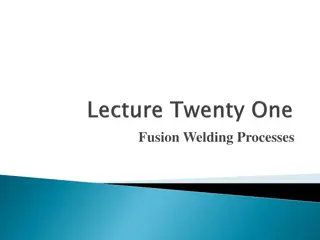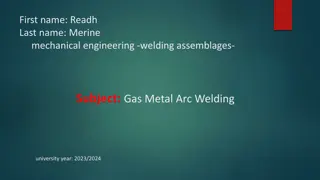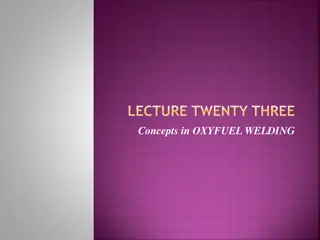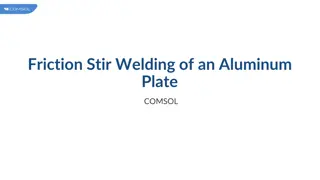Lecture 19 Heat Flow in Welding I
Heat flow in welding plays a crucial role in determining the metallurgical structure, residual stresses, and mechanical performance of welded joints. Understanding the thermal cycle, soak temperature, and heterogeneous nature of welding is essential for achieving quality welds with minimal distortion.
Download Presentation

Please find below an Image/Link to download the presentation.
The content on the website is provided AS IS for your information and personal use only. It may not be sold, licensed, or shared on other websites without obtaining consent from the author.If you encounter any issues during the download, it is possible that the publisher has removed the file from their server.
You are allowed to download the files provided on this website for personal or commercial use, subject to the condition that they are used lawfully. All files are the property of their respective owners.
The content on the website is provided AS IS for your information and personal use only. It may not be sold, licensed, or shared on other websites without obtaining consent from the author.
E N D
Presentation Transcript
Lecture 19 Heat Flow in Welding I
Heat Flow in Welding- Importance -Arc welding processes involve the melting of the faying surfaces and the filler metal, followed by solidification of the molten weld metal. -Melting and solidification steps of welding are associated with the flow of heat and are affected by rate of heat transfer in and around the weld metal -Metallurgical structure of metal in weld and region close to the weld metal is mainly determined by the extent of rise in temperature and then cooling rate experienced by the metal at particular location of HAZ and weld -Further, differential heating and cooling experienced of different zones of weld joint cause not only metallurgical heterogeneity but also non- uniform volumetric change which in turn produces the residual stresses
Homogeneous and Heterogeneous -Homogeneous, means of the same kind, consisting of parts all of the same kind (it is also the name for a chemical process involving substances in the same phase, i.e. all liquids or all gases, if that helps you remember it). -Heterogeneous, means diverse in character or content (a heterogeneous chemical process is one involving substances in different phases, e.g. mixing a gas with a liquid, in case that helps you remember). -Soak Temperature -It is a temperature range where the heated weld part is held for some time, to effectively reduce the stress level. Soak Temperature is set according to the type of material and normally ranges from six hundred (600) to seven hundred and sixty (760) degree Celsius. -Soak Time -It is a specific time during which the material is allowed to heat at sock temperature range,
Heat Flow in Welding- Importance -These residual stresses adversely affect the mechanical performance of the weld joint besides distortion in the welded components if proper care is not taken -Since heating, soaking and cooling cycle affect the metallurgical & mechanical properties, development of residual stresses and distortion of the weld joints therefore it is so important to study various aspects related with heat flow in welding such as: weld thermal cycle, cooling rate and solidification time, peak temperature, width of heat and affected zone.
Weld Thermal Cycle -Weld thermal cycle shows variation in temperature of a particular location (in and around the weld) during the welding as a function of welding time. As the heat source (welding arc or flame) approaches close to the location of interest first temperature increases heating regime followed by gradual decrease in temperature cooling regime. -A typical weld thermal cycle (Figure below) shows the rate of heating (slope of a b), peak temperature, and time required for attaining the peak temperature, cooling rate (slope of b c).
Weld Thermal Cycle -Since distance of the point of interest away from the weld centerline directly affects all the above parameters heating and cooling rate, peak temperature of weld thermal cycle therefore each location/point offers different and unique weld thermal cycle (Figure above). -In general, an increase in distance of point of interest away from the weld center- line: decreases the peak temperature decreases the rate of heating and cooling increases time to attain peak temperature decreases rate of cooling with increase in time
Factors affecting welding thermal cycle -However, weld thermal cycle varies with distance form the weld center line but it is also influenced by heat input rate, amount of heat supplied for welding, weldment geometry, thermal properties of base metal and initial plate temperature. -Rate of heat input is primarily governed by the energy density of heat input source which to a great extent depends upon the welding process being used for development of weld joints besides the welding parameters. -High energy density processes like plasma arc welding and laser beam welding offer higher rate of heating, peak temperature and cooling rates than low energy density processes such as gas welding, shielded metal arc welding as shown in Fig. below Higher is the energy density of welding process, lower will be the heat input.
Factors affecting welding thermal cycle -Weld geometry parameters such as thickness of plates being welded also affect the heating rate, soaking time and cooling rate for a given rate of heat input (welding parameters) owing to changes in heat transfer condition. -In general, an increase in thickness of plate increases the rate of heat transfer from the weld pool/heat affected zone to the base metal which in turn a)decreases the high temperature retention time of HAZ, b) decreases the solidification time and c) increases the cooling rate experienced by the HAZ and weld metal. -Thermal properties of metal like thermal conductivity and specific heat also have affect on weld thermal cycle similar to that of thickness of plates as they increase the rate of heat transfer from the weld metal and HAZ. -Preheating of the plates reduces the rate of heating and cooling and increases the peak temperature and soaking period above certain temperature because preheating reduces the rate of heat transfer away from the weld zone.
Factors Affecting Welding Thermal Cycle -Peak temperature near the weld fusion boundary decides the width of heat affected zone (HAZ). -Heating and cooling rate affect the microstructure of weld metal and HAZ therefore weld thermal cycle of each point becomes of great interest especially in structure sensitive metals like high carbon steels.
Cooling Rate -The final microstructure of weld zone and HAZ is primarily determined by the cooling rate (CR) from the peak temperature attained due to weld thermal cycle during welding. -Cooling rate above a particular temperature say 550 oC for plain carbon eutectoid steel is of great importance in case of harden able steel where a cooling rate (CR) determines the final microstructure and mechanical properties of weldment and HAZ. Since microstructure of harden able steel has direct correlation with mechanical properties therefore, structure sensitive mechanical properties are affected by the cooling rate experienced by the weld metal and heat affected zone.
Cooling Rate This is evident from the continuous cooling diagram of hypo-eutectoid steel as shown in Fig. 19.4. In the diagram, letter A, F, P, B, M indicates regions of austenite, ferrite, pearlite, bainite and martensit respectively.
Cooling Rate -Weld thermal cycle indicates both heating and cooling rate. Cooling rate varies as a function of time, location of point of interest and temperature during cooling regime of weld thermal cycle. -The cooling rate calculation for HAZ of harden able steel weld joint is mostly made at 550 0C as cooling rate at this temperature predominantly decides the end microstructure and mechanical properties of the HAZ and weld joint. -During welding, two welding parameters decided the cooling rate a) net heat input during the welding and b) initial plate temperature besides the thermal and dimensional properties of material being welded. -In general, increases in heat input decreases the cooling rate while reverse happens with increase of initial plate temperature during welding of a given metal having specific thickness and thermal properties.
Cooling Rate -An increase in both heat input and initial plate temperature raises temperature of base metal around the weld which in turn decreases the rate of transfer away from the weld zone primarily due to reduction in temperature difference between the weld zone and surrounding base metal. -Reduction in heat transfer rate from the weld metal to the base metal with increase in heat input and nitial plate temperature means decrease in cooling rate. -In view of above, major practical application of cooling rate equation is to determine the preheat requirement for plate to be welded so as to avoid critical cooling rate in weld and HAZ. -Net heat input (Hnet) during welding is obtained using following relationship: Hnet = f .VI/S where V is arc voltage (V), I welding current (A) and mm/sec and f is the fraction of heat generated and transferred to the plate. S welding speed
